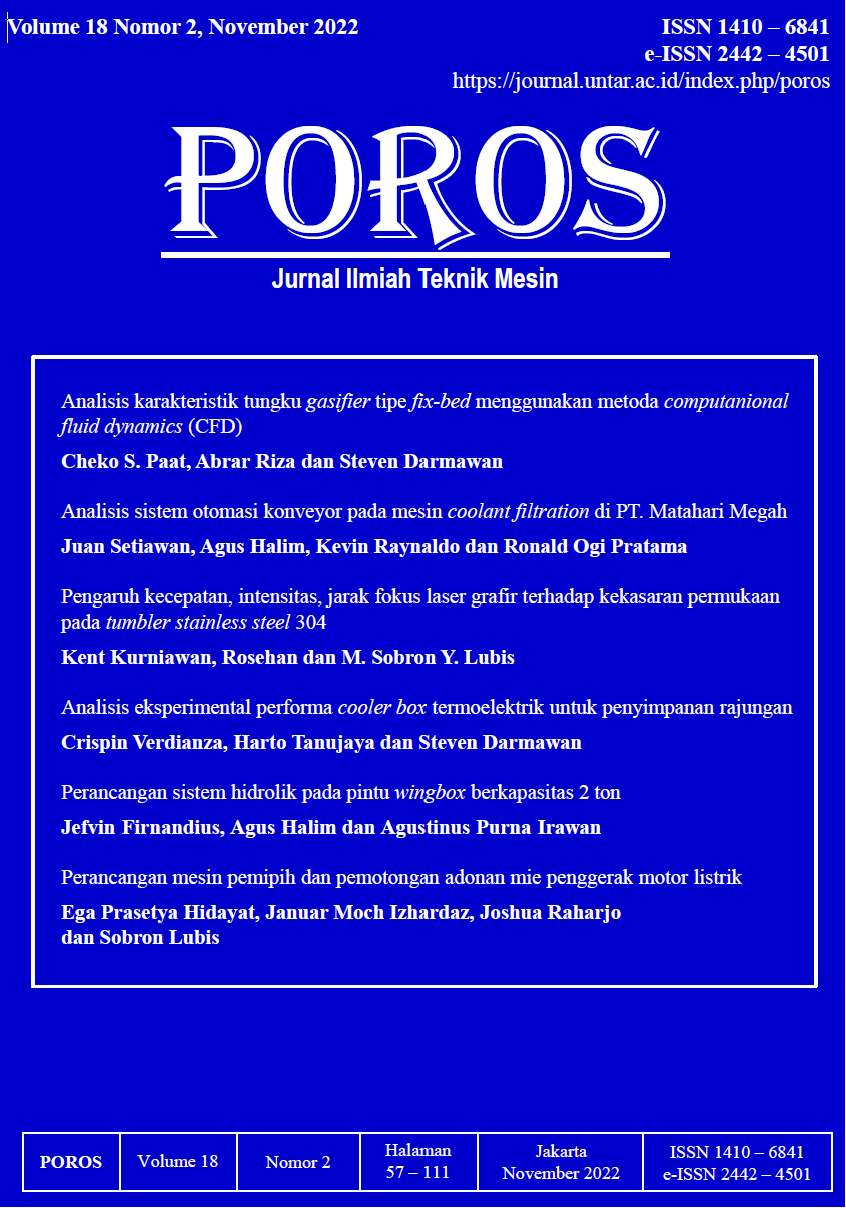ANALISIS SISTEM OTOMASI KONVEYOR PADA MESIN COOLANT FILTRATION DI PT. MATAHARI MEGAH
Main Article Content
Abstract
Coolant Filtration Machine is one of the products of PT. Matahari Megah. The purpose of this
machine is to recycle residual coolant fluid that has been used in the machining process. Coolant Filtration
Machine is working through automation system which involves conveyor system controlled by sensors. The
components involved need to be analyzed and calculated properly to work as designed. Hence, calculation
for required electricity power to move the wire mesh conveyor used in this machine was done. According to
the process, it was concluded that the required power is 60 Watt. A pair of sensors are mounted to control the
movement of this conveyor are proximity sensors which monitor the water container and lever limit switch
monitoring the paper holder system.
Article Details
Section

This work is licensed under a Creative Commons Attribution-NonCommercial-ShareAlike 4.0 International License.

This work is licensed under a Creative Commons Attribution-NonCommercial-ShareAlike 4.0 International License.
References
Nurahmad Aprianto Jauhari, “Pengaruh Media Pendingin (Coolant) dan Geometri Pahat Potong
Terhadap Tingkat Kekasaran dan Makrostruktur Pada Pembubutan Memanjang Bahan Baja
EMS-45,” vol. 3, no. 8, pp. 1–12, 2017.
W. W. P. Sri Widiyawati, Oyong Novareza, Dwi Hadi S., “Pengaruh Penggunaan Cairan
Pendingin (Coolant) Terhadap Keausan Pahat Bubut HSS,” no. December, pp. 467–475, 2020.
S. Sundari, “Pengaruh Perbedaan Tekanan Terhadap Kinerja Plate and Frame Filter Press Pada
Filtrasi Ampas Tahu (The Effect of Different Pressure on the Plate and Frame Filter Press
Performance on Tofu Waste Filtration ),” pp. 5–6, 2019.
“3 Kelebihan Wire Mesh Conveyor Untuk Mempercepat Lini Produksi.”
https://datumpresisi.co.id/wire-mesh-conveyor/ (accessed Sep. 18, 2021).
M. Sochib, G. M. Kusbiantoro, P. Studi, T. Mesin, F. Teknik, and U. Gresik, “Perencanaan Belt
Conveyor Batu Bara Dengan Kapasitas 1000 Ton Per Jam Di PT. Meratus Jaya Iron Steel Tanah
Bumbu,” vol. 07, 2018.
M. Yusro and A. Diamah, Sensor Dan Transduser (Teori dan Aplikasi). Jakarta: Universitas
Negeri Jakarta, 2019.
A. P. Irawan, Diktat Elemen Mesin. Jakarta: Universitas Tarumanagara, 2009.
Z. Khan, “FAQ: How to choose a safety factor so a motor design lasts?,” 2016.
https://www.motioncontroltips.com/faq-choose-safety-factor-motor-design-lasts/ (accessed
Sep. 28, 2021).
M. A. A. Wiraguna, N. K. D. Natalia, R. D. Bintang, and I. G. R. A. Nugraha, “Otomatisasi
Dalam Pandemi Dengan Sensor Proximity,” Politek. Negeri Bali, no. December, 2020.
F. M. Sigit, “Perancangan Proximity Sensor Berbasis Kapasitif Untuk Kontrol Pintu Otomatis,”
Proceding Semin. Tugas Akhir Tek. Elektro FTI-ITS, pp. 1–11, 2010.
M. Saleh and M. Haryanti, “Rancang Bangun Sistem Keamanan Rumah Menggunakan Relay,”
Tek. Elektro, vol. 8, no. 3, pp. 181–186, 2017.

